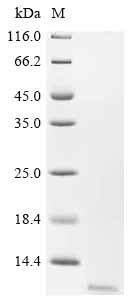The process of producing the recombinant mouse Glucagon (Gcg) with an N-terminal 6xHis-tag in yeast starts with cloning the target gene, linked with the 6xHis-tag sequence, into an expression vector, followed by transformation into yeast cells. The target gene corresponds to the 21-89aa of the mouse Gcg. After induction of protein expression, the yeast cells are lysed to release the 6xHis-tagged recombinant Gcg protein, which is purified using nickel affinity chromatography. Its purity is analyzed by SDS-PAGE, reaching over 95%.
Glucagon (Gcg) is a peptide hormone that plays a crucial role in regulating glucose metabolism in the body. It is primarily produced by the α-cells of the pancreas and acts to elevate blood glucose levels by stimulating the release of glucose from the liver and promoting glycogen breakdown [1]. Glucagon is a potent regulator of energy balance, glucose, and lipid metabolism, highlighting its significance in maintaining metabolic homeostasis [2].
Research has shown that glucagon deficiency can have metabolic consequences, emphasizing the importance of this hormone in overall metabolic health [3]. Studies have also demonstrated that glucagon stimulates exocytosis in pancreatic α-cells by binding to glucagon receptors, indicating its role in regulating insulin and glucagon secretion [4].
Furthermore, the transcription factor MafB has been identified as critical for the production and secretion of glucagon in pancreatic α-cells [5]. MafB is essential for glucagon production and secretion postnatally, highlighting its significance in the maturation of pancreatic islets [6][4].
References:
[1] X. Ma, Y. Zhang, J. Gromada, S. Sewing, P. Berggren, K. Buschardet al., Glucagon stimulates exocytosis in mouse and rat pancreatic α-cells by binding to glucagon receptors, Molecular Endocrinology, vol. 19, no. 1, p. 198-212, 2005. https://doi.org/10.1210/me.2004-0059
[2] T. Kim, S. Nason, C. Holleman, M. Pepin, L. Wilson, T. Berryhillet al., Glucagon receptor signaling regulates energy metabolism via hepatic farnesoid x receptor and fibroblast growth factor 21, Diabetes, vol. 67, no. 9, p. 1773-1782, 2018. https://doi.org/10.2337/db17-1502
[3] Y. Hayashi, Metabolic impact of glucagon deficiency, Diabetes Obesity and Metabolism, vol. 13, no. s1, p. 151-157, 2011. https://doi.org/10.1111/j.1463-1326.2011.01456.x
[4] M. Katoh, Y. Jung, C. Ugboma, M. Shimbo, A. Kuno, W. Bashaet al., Mafb is critical for glucagon production and secretion in mouse pancreatic α cells in vivo, Molecular and Cellular Biology, vol. 38, no. 8, 2018. https://doi.org/10.1128/mcb.00504-17
[5] C. Shiota, K. Prasadan, P. Guo, Y. El-Gohary, J. Wiersch, X. Xiaoet al., Α-cells are dispensable in postnatal morphogenesis and maturation of mouse pancreatic islets, Ajp Endocrinology and Metabolism, vol. 305, no. 8, p. E1030-E1040, 2013. https://doi.org/10.1152/ajpendo.00022.2013
[6] Y. Chang, M. Katoh, A. Abdellatif, G. Xiafukaiti, A. Elzeftawy, M. Ojimaet al., Uncovering the role of mafb in glucagon production and secretion in pancreatic α-cells using a new α-cell-specific <i>mafb</i> conditional knockout mouse model, Experimental Animals, vol. 69, no. 2, p. 178-188, 2020. https://doi.org/10.1538/expanim.19-0105






